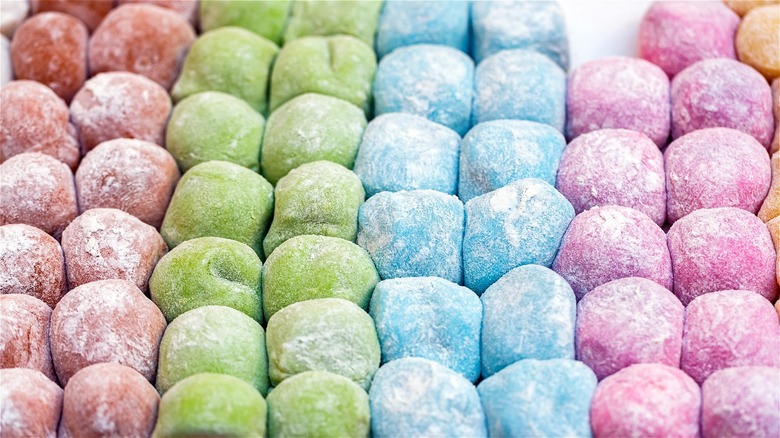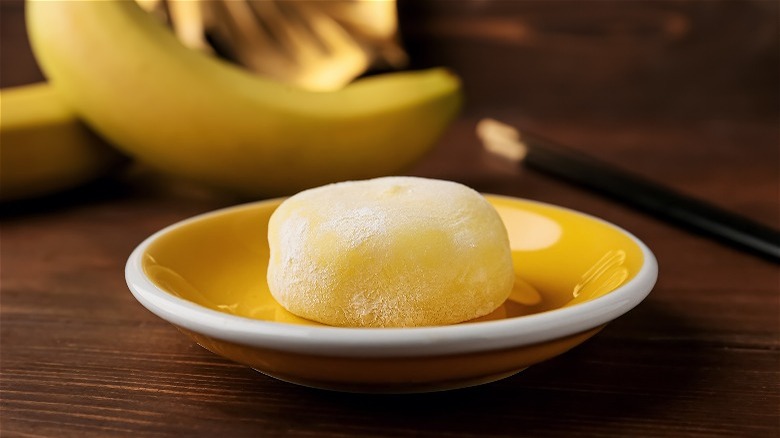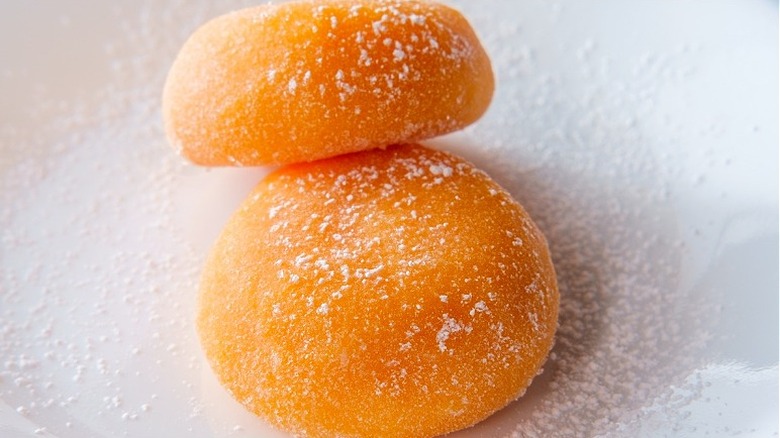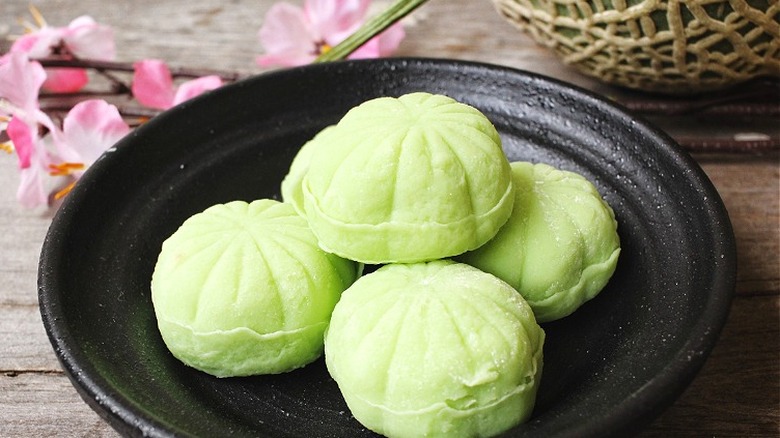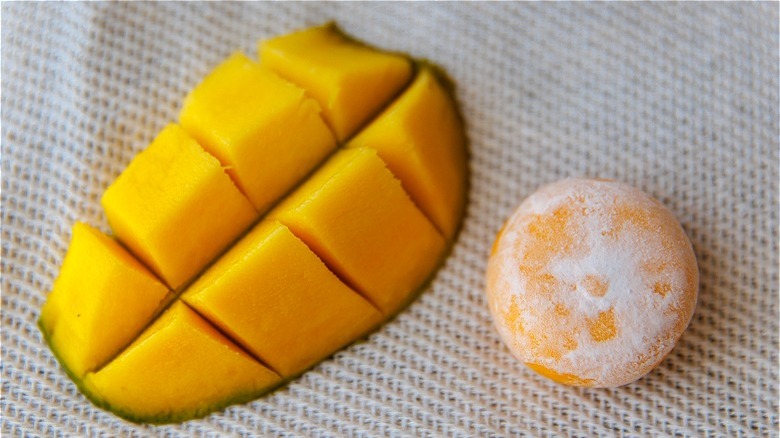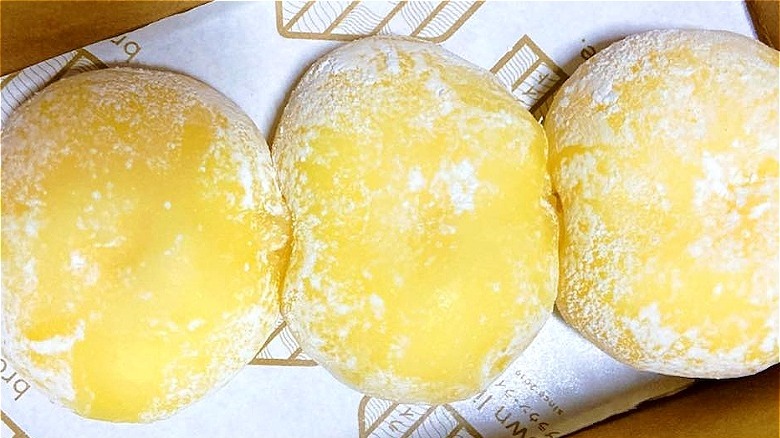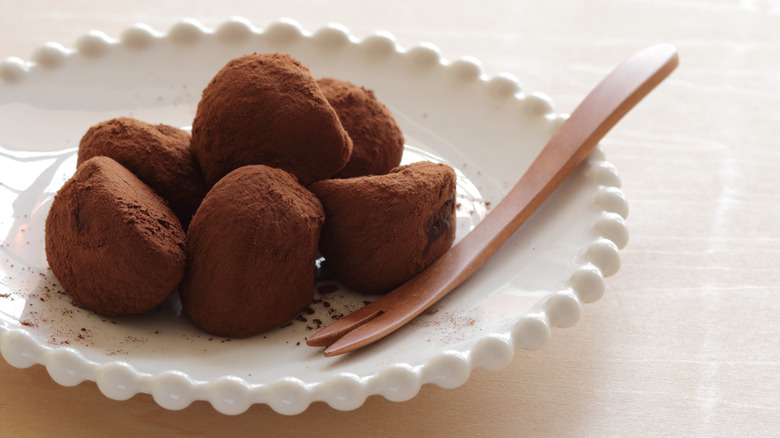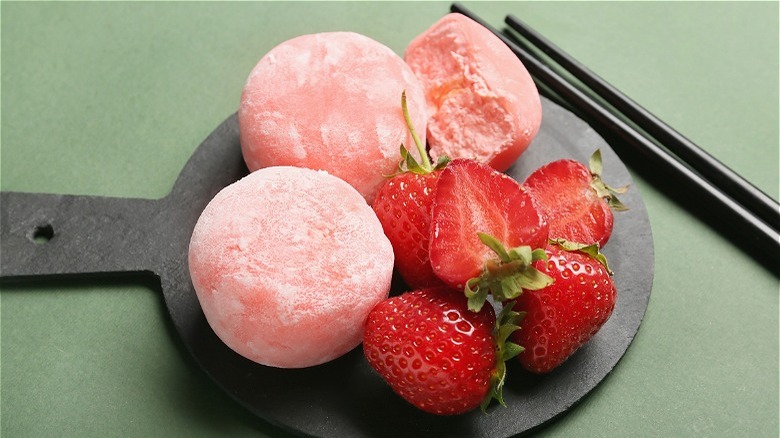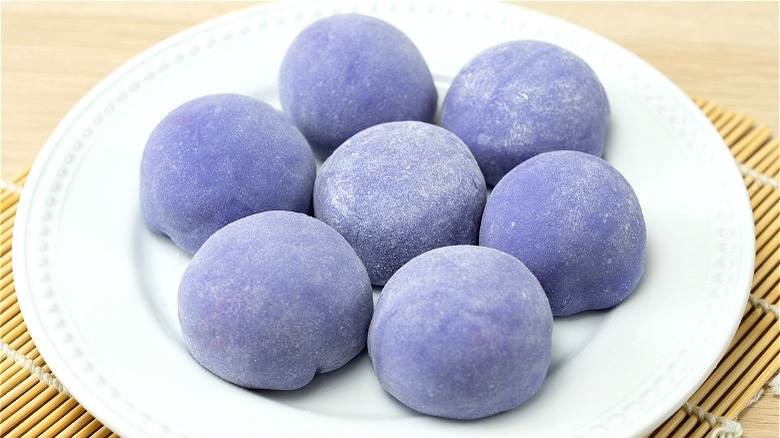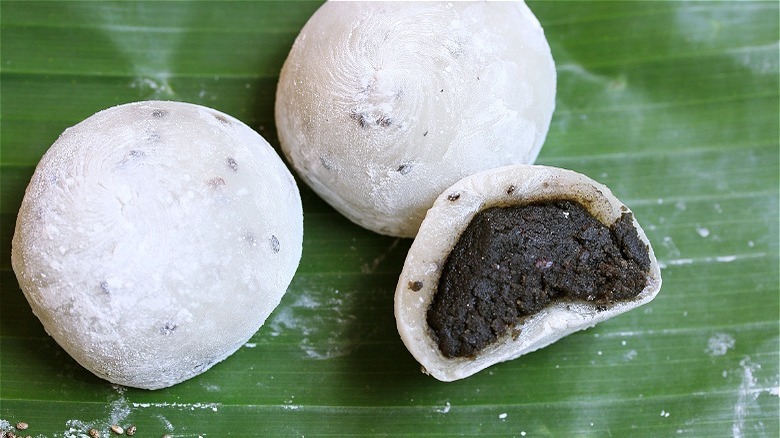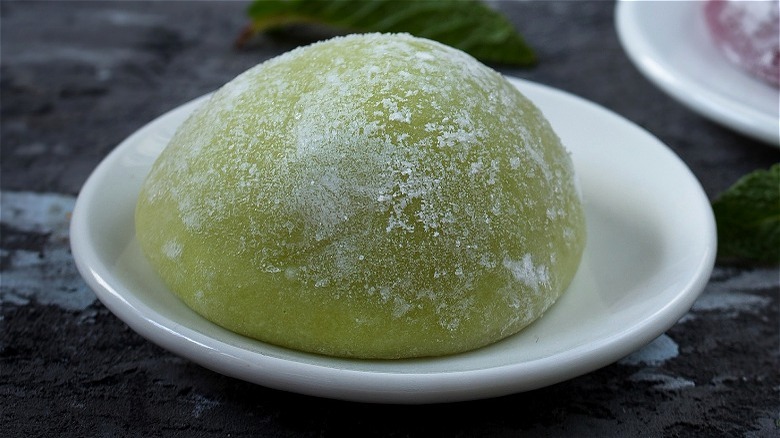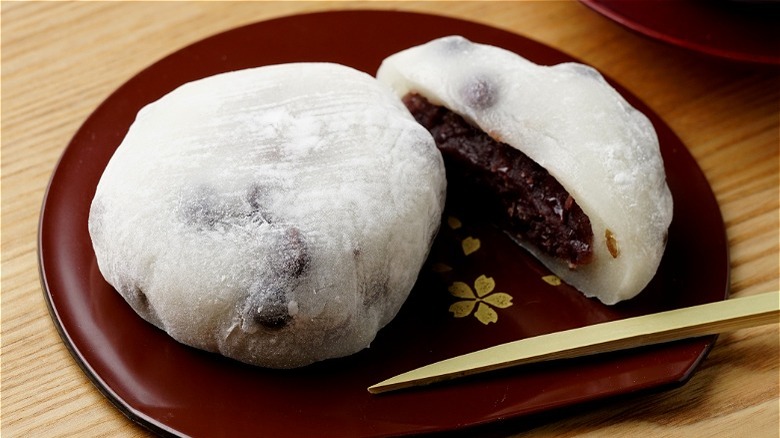11 Best Mochi Flavors Ranked
We may receive a commission on purchases made from links.
Mochi is a sweet or savory Asian snack known for its soft and chewy texture. The treats originated in Japan, where you can find dozens of different flavors often served as dessert (via Food in Japan). Nonetheless, the various renditions usually have a few constants, especially among mochis that are round and filled — the kind we're sinking our teeth into for this story.
All mochis are made from glutinous rice or glutinous rice flour. This main ingredient is unique because when it's ground and processed, it forms a sticky, stretchy, moldable dough (via Food in Japan). For sweet versions, sugar is mixed into the dough and a filling is usually added; fruit, red bean paste, ice cream, and flavored jam are some popular options. Once the filled pastry is assembled, the mochi is typically rolled into a ball, then coated in potato starch to prevent sticking (via Taste Atlas).
The recipe for mochi may seem simple, however, there are always fluctuations in quality. A huge determining factor is the mochi's flavor. Is it fruit-inspired or traditional, like matcha or red bean? Is it too sweet or too bland? We're here to give you our advice on the top 11 mochi flavors, ranked worst to best.
11. Banana
Fruit inspires many mochi flavors and banana is one of them. The light yellow appearance of these mochis is perhaps cute, but in the taste department, banana-flavored mochi is largely unsuccessful. These sweets tend to be bland and unsatisfying, and it has not gone unnoticed by consumers online. On Bokksu Grocery's retail website, a customer wrote that Kubota's daifuku mochi had a "subtle flavor." Another said, "Love it, but banana flavor could be a bit stronger." We're pretty sure they are just being polite.
Even when the mochis are made with real bananas, the issue is that the texture of banana mochi is frightfully inferior to the fruit itself. You take a bite expecting the softness of the peelable fruit, but you end up having to do a lot more chewing. The effect leaves much to be desired. We don't mind fruit-flavored dessert, but we'll pass on banana mochi.
10. Orange
As far as fruit-flavored mochis go, orange is certainly not a standout. All the same, it is surely a step above banana. Nobody is biting into an orange-flavored mochi expecting the texture of an orange. In our opinion, this improves the experience of eating these treats. If the mochi happens to have real fruit in it, that's even better.
Still, this flavor doesn't have a great track record for this glutinous treat. A reviewer on Bokksu Grocery wrote, "The mochi itself is very delicious! But I was not a fan of the orange flavor." There's a reason why oranges aren't used to flavor desserts alone. Most other orange desserts combine the fruit with frosting, cream, or chocolate. That's because alone, orange is boring — you would be better off eating the actual fruit.
But orange mochi has a few interesting elements going on. For one, the flavor itself is somewhat complex given the contrast of sweetness and tanginess. At leas this factor adds a little excitement to orange-flavored mochi.
9. Melon
Melon is a popular mochi flavor, but a somewhat ambiguous term. Cantaloupes and honeydews are types of melons, and watermelons are relatives (via Britannica). But none of them really taste all that similar. As for the melon flavor used to make mochi, it's more along the lines of cantaloupe and honeydew. Melon flavoring isn't as generic to non-American audiences, and according to Advanced Biotech, a rise in melon-based Asian desserts is slowly spreading to the U.S.
Mochis flavored with melon are often green, inside and out (like honeydew). Other versions are green on the outside and orange on the inside (like cantaloupe), per YamiBuy. These mochis can even have an orange exterior, like a product sold by Bokksu Grocery. Since the appearance varies, it isn't an important factor in our ranking.
However, the problem is that melon mochis are bland. Although the flavor is inspired by a refreshing fruit, the process of turning it into a confectionary is unsuccessful. On Amazon, one person commented, "My daughter said it tasted like nail polish. Was supposed to be melon." Another person wrote, "I threw melon ones away, since I couldn't bear to taste them." We could possibly chalk up some of the hate for this flavor to its novelty. But we would probably not choose to buy melon mochi — there are better options out there.
8. Mango
Mangoes are tropical, creamy, mildly sweet, and slightly acidic. Pineapple, coconut, melon, and pine are common tasting notes to describe the fruit (via Foods Guy). All the same, flavors can vary depending on the ripeness of your mango — and it can be challenging to find a perfectly ripe mango.
Unfortunately, the flavor of mango doesn't translate well when used in mochi. You completely miss the fresh, juicy effect of biting into a ripe mango, and its simplicity and sweetness are entirely lost in the starchy dessert. Combining dehydrated mango flavoring with powdery ingredients isn't recommended. The main problem is the characteristic blandness of dried mango powder. It just doesn't lend itself well to becoming a flavoring for desserts. There's a reason why other popular mango desserts such as Thailand's mango sticky rice use fresh mango.
Many reviewers for the mango-flavored mochi sold on Yami Buy agreed with our opinion. Only 60% of the reviews gave the product five stars. "Not particularly sweet, not particularly outstanding," wrote one reviewer. "Buy carefully. I ate one and didn't want to eat the rest," wrote another person. Not all mango mochis are bound to be this bad. If they are executed with fresh fruit, this dessert has some potential.
7. Yuzu
Yuzu mochi is the best citrus fruit-flavored mochi — hands down. Flavoring comes from the yuzu fruit, which is sometimes referred to as the Japanese lemon (via Sushi Modern). This fruit is naturally tart, sour, and slightly sweet, much like other citrus fruits. As for the flavor, it is commonly described as a combination of lemon, orange, and grapefruit. These juices can even be combined to make a yuzu juice substitute. Meyer lemon, a hybrid fruit made from lemons and mandarin oranges, is another useful comparison for yuzu.
This flavor is the perfect storm when it comes to mochi. The fruit's tartness is balanced by the sugar and rice flour used to make mochi. The result is a chewy match made in heaven, that could be compared to a bite-sized, squishy lemon bar. To top it all off, the aesthetics are great. The color of yuzu mochi is typically a deep, bright yellow, which certainly gives it a more satisfying look than banana mochi. The whimsically-colored treat is vibrant and inviting, much like the best desserts tend to be.
However, the sweetness is mostly provided by sugar and not the yuzu flavor itself. While the ingredients pair well together, we'd appreciate it if the fruit was doing more of the work. Another downside? It's harder to find this flavor.
6. Chocolate
Chocolate mochi has its place in the world of desserts. It can easily satisfy two cravings at once, however, the result is not always the best of both worlds. The chocolate used to create this type of mochi is often second-rate. Whether the mochis are filled with chocolate cream, chocolate ice cream, chocolate bean paste, or something else altogether, it still isn't at the top of our list.
It's clear to every mochi eater that the chocolate used is often low quality. At the very least, an acceptable chocolate's first ingredient should be cocoa beans, per Read Cacao. However, with popular chocolate mochis such as a product made by Kubota, the chocolate mochi filling is made mostly of sugar and vegetable oil. In turn, this comes across in the lack of richness in taste, and you won't get to choose between milk or dark chocolate, much less learn the percentage of cacao in your mochi. These types of treats rarely disclose that type of information on the packaging. You would be better off enjoying a different form of chocolate, or a better mochi flavor.
However, the essential pairing of chewiness and chocolate is not all off. Think of a brownie. Think of Trader Joe's Chocolate Mochi Cake Mix. There is something comforting and indulgent in a very obvious, childlike way. As Umami Cart writes of one of its chocolate mochi products, "They are the perfect bite-sized dessert to eat after a meal!"
5. Strawberry
At least in the U.S., strawberry-flavored mochis are common. You can find them at Whole Foods and at Trader Joe's. They can be filled with ice cream, red bean paste, or jam. Whichever way they come, these treats are usually good, and you can rest assured that strawberry is consistently one of the best mochi flavors.
Strawberry is the whole package; it's sweet, fruity, and approachable. If you've never had mochi before, then strawberry is the way to go. The flavor is predictable because it's so commonly used as an artificial food flavoring, in candy or otherwise. This also means it translates well to desserts. From the strawberries, you get sweetness and fruitiness. This can balance out the bland aspect of glutinous rice that is used to make mochi.
One downside of strawberry-flavored mochi can also be its greatest asset. That sweetness is sometimes just enough, but other times ends up being way too much. Many Amazon customers who reviewed one particular strawberry mochi product agreed: "I had to drink water between bites to drown out the overbearing sweetness," wrote one person. However, others noted the extreme sugar factor with pleasure: "Super sweet and perfect texture, will try other flavors soon," said a more positive reviewer.
4. Taro
You'll find many purple-colored mochis marked with the names taro or ube. The two flavors are distinct and come from two different root vegetables, but they can end up tasting similar in processed foods. Taro, which is naturally less sweet and purple than ube, is often sweetened and dyed by manufacturers (via Bon Tea Cafe). This means it can end up looking and tasting like ube when used for desserts. Here, we'll focus on taro-flavored mochi, because it seems to be easier to find. Companies like Royal Family, Daifuku, and Formosa Yay all make taro-flavored mochi.
Dessert taro is sweet, nutty, and mild, with hints of vanilla, explains Foods Gal. This subtle flavor creates a perfect canvas for mochi. With an adjustable sweetness (since taro isn't naturally sweet) mochi makers can avoid an overpowering amount of sugar. Meanwhile, the hints of vanilla and nuttiness provide a rounded-out palate. Overall, taro mochi can be done right.
We will even look past the times when this flavor doesn't perform the best. For the beauty that is this purple-colored delight, we will forgive the instances (and there are many) when taro is too sweet. The real problem we have is that this flavor isn't so natural. Given the lengths that mochi makers have to go through to make taro both sweet and purple, we can't rank this item higher on this list.
3. Black sesame
Black sesame flavoring is made from toasted sesame seeds that are processed into a paste or powder, becoming the flavoring we know and love (via Bokksu). Sometimes, mochis are even coated in an outer layer of black sesame seeds, like Daifuku's product.
As a flavor, black sesame is mostly nutty, slightly bitter, and sometimes rich in flavor, per Taste. Since this flavor pairs well with red bean — a type of bean that's cooked and sweetened for mochi filling — this is excellent news. Unlike taro which needs a lot of help to become interesting, black sesame is inherently rich and flavorful. This makes it a great candidate to be diluted and sweetened with sugar.
Reviews for the black sesame mochi ice cream sold on Goldbelly are outstanding: "Delicious mochi. Like, really really good," wrote one person. On Amazon, one person described a similar product as having a "Heavenly texture, great flavor." Across different companies and brands, mochi made with black sesame flavoring comes out good. The only downside is its rareness as it can be hard to get your hands on this mochi flavor. But when you can, it's all worth it.
2. Matcha
To make matcha, the green tea plant is shielded from the sun and quickly dried to preserve its bright green color. As a flavor, matcha tastes vegetal and sweet, with a savory umami quality as well (via Artful Tea). Not only is the appearance brighter than green tea, but the taste is more intense as well. In terms of mochi, it's one of the most powerful and complex flavors around. As such, we think it's one of the best.
The flavor of matcha is naturally delicately sweet. Pure matcha is nothing like the flavor of your bubble teas or green tea ice creams — sugar has to be added. That's why matcha-flavored mochis will vary in sweetness. The main complaint with matcha drinks is that they are either too sweet or not sweet enough. However, unlike matcha-flavored drinks, we welcome sweetness in our matcha-flavored mochis. Thanks to the savory notes, it's going to be good either way. This flavor easily thrives in its mochi form.
On Bokksu Grocery, users give Kabota's matcha green tea mochi high praise: "This mochi is small and delicate with a light taste. Not much sugar, it is just right," wrote one person. On Umamicart, a reviewer said, "These matcha green tea mochi are another great treat! Excellent texture and flavor." No matter where you get them, these mochis are bound to be good. We chalk that up to the infallibility of matcha flavoring.
1. Red bean
Red bean, made from adzuki bean paste (per Masterclass), is our top choice for mochi flavors. You'll find red bean paste often used as a filling for various mochi flavors, such as yuzu or matcha. But you'll also see it as the main event. In these instances, red bean paste is usually hidden inside a white chewy shell. This bean paste is so delicious, unique, and pleasantly soft, that it doesn't need anything else to shine.
The flavor of red bean paste is nutty, earthy, and savory (via Thrive Cuisine). There is a subtle sweetness, but most of it comes from added sugar. Along with adding sugar, the beans are cooked in water and processed. Some red bean pastes are less smooth than others, leaving rough grainy pieces hidden in the mushy paste (via Blog Chef). Much like how a coating of sesame seeds adds texture to mochi, this adds some excitement to each bite.
On World Market, reviewers rave about the red bean mochi: "The Red Bean Mochi is absolutely delicious! Not too sweet and a tasty treat!" said one person. "They are subtly sweet and filling," wrote another. With red bean-flavored mochi, the sweetness of the filling and the shell play off one another — both are sweet. Similarly, the textures of the interior and exterior are both soft. These duplicities serve to create a peak mochi experience.
